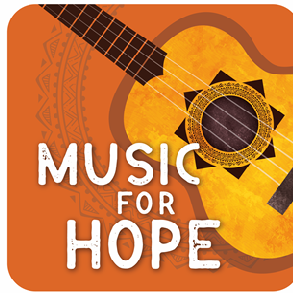Music For Hope - Our Story
Introduction
Music for Hope was originally designed to give youths who were suffering the trauma of recent civil-war an alternative creative focus. Its initial goal soon became one of generating self-perpetuating, non-violent culture amongst young people in a national and regional context of ever-increasing social violence and criminality. The project participants have worked over the past two decades to counter the ever-worsening cycle of violence against young people in the region.
Music for Hope, set up to help youth cope with the trauma of war and displacement, quickly became dedicated to generating an alternative, non-violent youth culture, with solidarity and friendship as core virtues, shored-up by the discipline required to learn and perform music.
Music for Hope empowers youth in non-violent, self and group-expression, thereby undermining the discourses of violence that atomise and silence people—especially youth—through fear and stigmatisation.

Origins to the Present
There was a more profound goal to this than just ‘teaching music’. The idea and the method was to give them training based on the musical traditions of the local population. This was to help conserve these traditions, essentially, as both commemoration and testimony, but also as a type of informal therapy to help them recover from the trauma of the civil war and of displacement. The project was really popular amongst the young people of the communities and highly successful in meeting its goals, and some of the first young participants to be musically trained went on to become the project’s teachers. Over two decades later, the project is still working in the communities of the Bajo Lempa although the underlying aims have developed. It is now led by a small but dedicated team of Salvadoran teachers from the Bajo Lempa communities, and supported by solidarity from the UK and Catalunya.

This is the contemporary context in which Music for Hope now operates, so its primary purpose has shifted from that of helping young people overcome the trauma of violence and dislocation – which was its original aim – to that of providing a safe, neutral space in the communities for children and young people to spend time together, learn new skills (through music), and draw them away from the culture of violence that’s so prominent in the region. If they’re involved in the music project, they won’t be involved in the gangs, and this considerably lessens the danger that they’ll be targeted by gang members themselves or by death squads.
The discipline of learning music, meanwhile, transfers onto broader aspects of their lives, and that’s true on both individual and communal levels. It teaches them perseverance (through practice), responsibility and respect for each other (attending classes on time, following instructions from the teacher and behaving in a way that’s conducive to learning), and leadership (passing on what they’ve learned to younger participants—effectively teaching—and being examples to follow in terms of the other skills that are intrinsic to the project).
At the communal level, these children and young people come together (in music groups and choirs) and learn to socialise in a healthy and safe environment. The discipline and leadership that they learn through music feeds into wider community activities, and many become active in youth groups and later, community leadership. The music teachers and the project foster what’s effectively a non-violent counterculture to the endemic culture of violence that’s so prevalent in the region.

But there’s an outcome of the project that’s much further-reaching than this, and it’s the civic formation of young people in a culture that holds non-violence as a core-principle. The four music teachers for Music for Hope (who are local and themselves were trained by the project in its early years) don’t just teach classes and coach bands, but they also take on mentoring and even parental roles for the youngsters who participate in the project; they facilitate other non-musical activities that help nurture a sense of companionship as well as civic duty.
The games they play and activities they carry out strengthen the social bonds that are already forming as a result of the music practices, and the result is better music but also stronger cohesion, confidence, and ultimately, more stable lives for the boys, girls and young women and men who participate in the project.
There are currently four music teachers and one psychologist. Between them they cover approximately 12 different communities and teach approximately 150-250 youths a year (numbers vary from year to year depending on migration patterns and also the security situation which can affect whether these children and young people can travel between communities to go to music practice). The Salvadoran team is closely supported by a small team of volunteers in the UK and the solidarity that comes from donors in the UK, Catalunya and the wider world.

